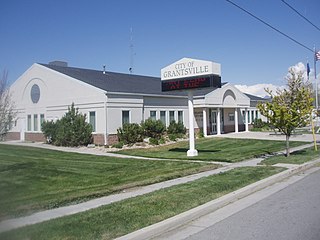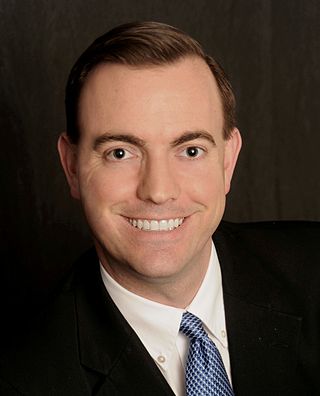Related Research Articles

Beaver County is a county in west central Utah, United States. As of the 2020 United States Census, the population was 7,072, up from the 2010 figure of 6,629. Its county seat and largest city is Beaver. The county was named for the abundance of beaver in the area.

Millard County is a county in the U.S. state of Utah. As of the 2020 United States Census, the population was 12,975. Its county seat is Fillmore, and the largest city is Delta.

Tooele County is a county in the U.S. state of Utah. As of the 2020 United States Census, the population was 72,698. Its county seat and largest city is Tooele. The county was created in 1850 and organized the following year.

Grantsville is the second most populous city in Tooele County, Utah, United States. It is part of the Salt Lake City, Utah Metropolitan Statistical Area. The population was 12,617 at the 2020 census. The city has grown slowly and steadily throughout most of its existence, but rapid increases in growth occurred during the 1970s, 1990s, and 2010s. Recent rapid growth has been attributed to being close to Salt Lake City, small town community feel, lower housing costs than Salt Lake County, the nearby Deseret Peak recreational center, the Utah Motorsports Campus raceway, and the newly built Wal-Mart distribution center located just outside the city. It is quickly becoming a bedroom community for commuters into the Salt Lake Valley.

George Quayle Cannon was an early member of the Quorum of the Twelve Apostles of the Church of Jesus Christ of Latter-day Saints, and served in the First Presidency under four successive presidents of the church: Brigham Young, John Taylor, Wilford Woodruff, and Lorenzo Snow. He was the church's chief political strategist, and was dubbed "the Mormon premier" and "the Mormon Richelieu" by the press. He was also a five-time Utah territorial delegate to the U.S. Congress.

The Utah Supreme Court is the supreme court of the state of Utah, United States. It has final authority of interpretation of the Utah Constitution. The Utah Supreme Court is composed of five members: a chief justice, an associate chief justice, and three other justices. All justices are appointed by the governor of Utah, with confirmation by the Utah Senate. The five justices elect one of their own to serve as chief justice and another to serve as associate chief justice, each for a term of four years.
The 2nd Utah Territorial Legislature comprised members of the Territorial Council serving the second year of their terms, together with members of the House of Representatives elected to one-year terms. The regular election was held August 2, 1852. Due to multiple resignations in both chambers, a special election to fill the vacancies was held November 8, 1852. Members of the Territorial Council from the 1st Utah Territorial Legislature who resigned prior to the session included Orson Pratt, Orson Spencer, and John S. Fullmer.
The 17th Utah Territorial Legislature was elected on August 5, 1867.

Michael Kent Winder is an American businessman, author, and politician. He was the mayor of West Valley City, Utah between 2010 and 2014. A Republican, he subsequently represented District 30 in the Utah House of Representatives for three terms, from 2017 to 2022. He is the author of fourteen published books on Utah and LDS history, including Presidents and Prophets: The Story of America's Presidents and the LDS Church.
The Nebraska Territorial Legislature was held from January 16, 1855, until February 18, 1867, in Omaha City, Nebraska Territory.

John Riggs Murdock was a Mormon pioneer, Utah politician, and leader of the Church of Jesus Christ of Latter-day Saints in Beaver, Utah. He is sometimes credited as the leader of the most down-and-back companies in Latter-day Saint history, as he directed multiple ox-drawn wagon trains sent from Utah to bring back both merchandise and emigrating church members from back East. Murdock also served several missions in the eastern United States.
The Deseret Telegraph Company was a telegraphy company headquartered in Salt Lake City, Utah, United States. The company was organized in 1867 to direct operation of the recently completed Deseret Telegraph Line; its largest stakeholder was the Church of Jesus Christ of Latter-day Saints. The Deseret line ran north and south through the Utah Territory, connecting the numerous settlements with Salt Lake City and the First Transcontinental Telegraph. The company was dissolved in 1900 when its assets, including the Deseret line, were sold to the Western Union Telegraph Company.
The Legislative Assembly of the Territory of Utah was the legislative branch of government in Utah Territory, replacing the General Assembly of the provisional State of Deseret. The Act of Congress creating the territory in 1850 specified that the territorial legislature should consist of a council of 13 members serving 2-year terms, and a 26-member house of representatives elected for 1-year terms.
The 4th Utah Territorial Legislature comprised members of the Territorial Council serving the second year of their terms, together with members of the House of Representatives elected to one-year terms. The regular election for the House was held August 7, 1854. Several vacancies in Territorial Council were also filled at that time due to the death of Willard Richards and the resignations of Parley P. Pratt and John Taylor.
The 10th Utah Territorial Legislature comprised members of the Territorial Council serving the second year of their terms, together with members of the House of Representatives elected to one-year terms. The regular election for the House was held August 6, 1860. Several vacancies in the Territorial Council were also filled, including due to the resignations of Charles C. Rich and Orson Pratt.
The 11th Utah Territorial Legislature was elected on August 5, 1861.
The 12th Utah Territorial Legislature comprised members of the Territorial Council serving the second year of their terms, together with members of the House of Representatives elected to one-year terms. The regular election for the House was held August 4, 1862.
The 14th Utah Territorial Legislature comprised members of the Territorial Council serving the second year of their terms, together with members of the House of Representatives elected to one-year terms. The regular election for the House was held August 1, 1864.
The 15th Utah Territorial Legislature was elected on August 7, 1865.
The 18th Utah Territorial Legislature comprised members of the Territorial Council serving the second year of their terms, together with members of the House of Representatives elected to one-year terms. The regular election for the House was held August 3, 1868.
References
- ↑ "Annual Election, 1866". Deseret News. August 2, 1866. p. 8. Retrieved March 10, 2024.
- ↑ "Governor's Message". Deseret News. January 2, 1867. p. 8. Retrieved March 10, 2024.
- ↑ "The Past Session". Deseret News. January 23, 1867. p. 4. Retrieved March 10, 2024.
- ↑ "Beaver County History Background". Archived from the original on 2012-03-27. Retrieved 2012-07-24.
- ↑ "Washington County, Utah Boundary Changes". Wchsutah.org. 2012-10-20. Retrieved 2012-11-07.
- ↑ "Wrathall Involvement in the History of Grantsville". Rawbw.com. Archived from the original on 2002-12-31. Retrieved 2012-11-07.
- ↑ "Chapter 26-Bancroft's History of Utah 1540-1886". Utlm.org. Retrieved 2012-11-07.
- ↑ "Summit County, Utah: History and Information". E-referencedesk.com. Archived from the original on 2012-02-06. Retrieved 2012-11-07.